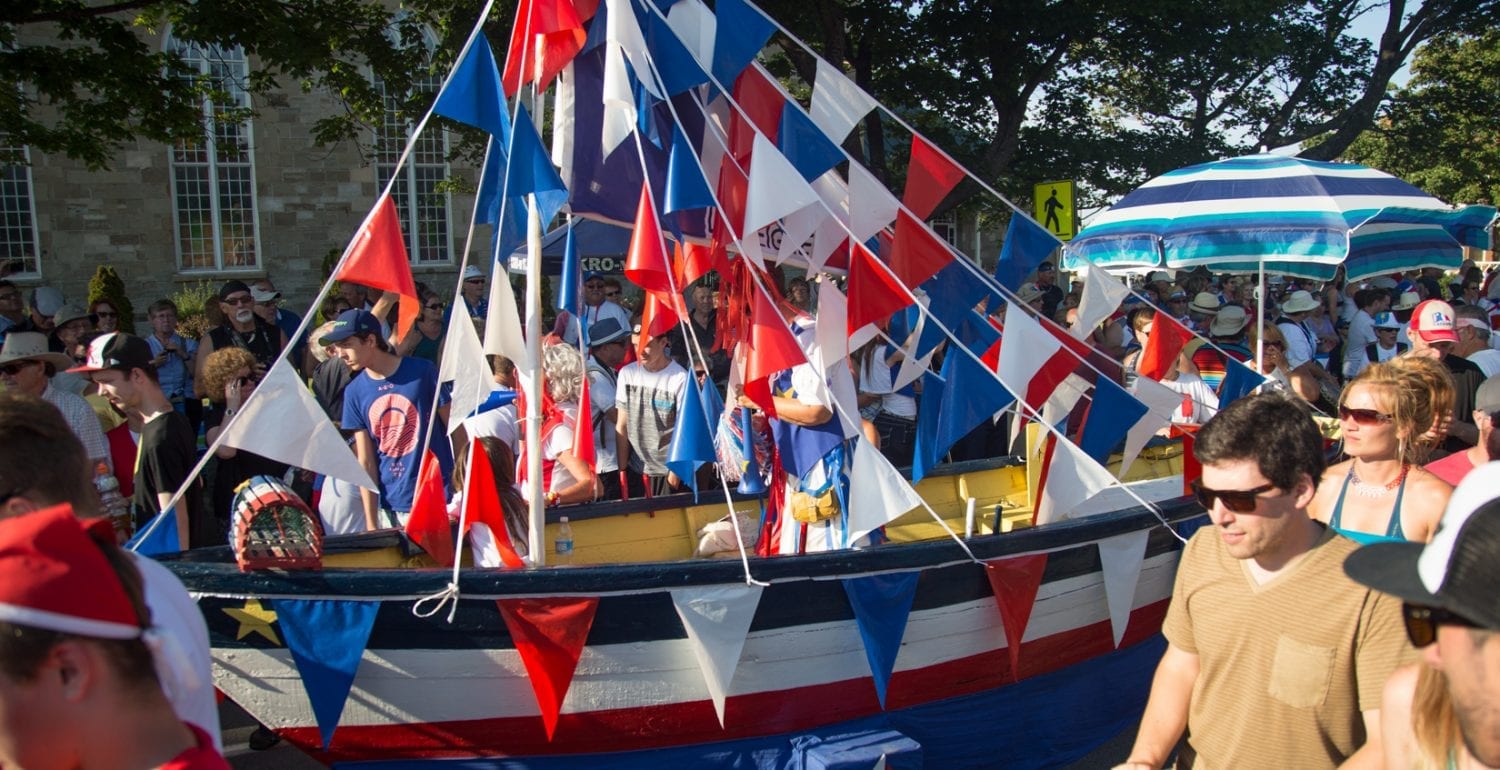On August 15, Let’s Celebrate National Acadian Day!

In 1881, the Acadians who met at Memramcook for their first National Convention chose August 15 as the date for their national holiday. Since then, Acadians get together on the day of the Assumption to commemorate their history and celebrate their culture. For some 40 years, this holiday has taken on a new meaning owing to a very unique event, the Tintamarre. In 1979, this noisy and colourful event became a central element of the celebration on the occasion of the 375th anniversary of the founding of Acadia, by emphasizing its festive side. Acadians use this event to express, loud and clear, their vitality, pride and joie de vivre, as they have been successful, against all odds, in preserving their culture. Since then, on August 15, Tintamarres, performances and joyous gatherings of all kinds take place just about everywhere where Acadians are living.
For more information…
Noisy rejoicing
The largest Acadian Tintamarre always takes place in Caraquet where this young tradition has grown significantly. On August 15, the last day of the Acadian Festival, tens of thousands of individuals invade the city to participate in this unique event. Exuberance carries the day: costumes and disguises in the colours of Acadia, Acadian flags, pots, plans, penny whistles, trumpets and other noise-making devices. A competition rewards individuals, couples, or families for the most original costumes and the most inventive noise-making devices so as to motivate the largest number of people to be creative and participate in the event. Workshops are even given during the Festival to help people prepare for it.
At the stroke of 6:00 pm when church bells are ringing, a frenzied parade starts to march through Caraquet. In the evening, a major musical performance (one that is harmonious) closes the Festival and National Holiday celebrations. Elsewhere in Acadia, on August 15, the celebrations include a mass, a family picnic, a parade of decorated trawlers, performances of all kinds, and more and more Tintamarres. The cities of Moncton and Dieppe organize their own Tintamarre, as do Bouctouche and Cheticamp, Shippagan and Petit-Rocher, Gatineau and Quebec City, Shediac and Kedwick, Bonaventure, Port-au-Port, Pointe-de-l’Église, and many other towns right up to Maine in the United States. Wherever Acadians live, festive gatherings spread the good cheer. National Acadian Day has become an explosion of joy to which everyone is invited.
Affirming one’s identity, defining one’s path
The option of celebrating the Acadian people on August 15 gave rise to some lively debates during the 1881 National Convention. Several delegates had just taken part in the second major National Convention of French-Canadians, which had been held the previous year in Quebec City, during which was borne the idea of uniting Acadians, based on the model of those French-Canadians who were trying to join forces in order to enhance their development. To choose a patron saint who would help Acadians tighten the fraternal bonds that unite, such as origin, race, language and religion, some delegates wanted to join the French-Canadians and opt for Saint-Jean-Baptiste Day. Others feared that if they did so, they would lose their Acadian identity. They emphasized the differences that set them apart from this other French-Canadian Catholic branch, the French-Canadians who were originally concentrated in the St-Lawrence Valley. Father Marcel-François Richard proved to be the most convincing of the delegates when he presented the fact that Acadians are a separate people, with a different history and a destiny of their own. Owing to his eloquence, everyone embraced his proposal of choosing Our Lady of the Assumption (that is, the Virgin Mary) as the patron saint of Acadians, and the feast of the Assumption, August 15, as the day of their national holiday. This option was approved by the Episcopate of the Maritime Provinces on September 16, 1881.
Origins of the Tintamarre
The Tintamarre is a much more recent tradition. The first event of this type took place in Moncton in 1955 to commemorate the Bicentennial of the Expulsion of Acadians. At that time, Archbishop Norbert Robichaud summoned all Acadian families to recite the bicentennial prayer at the sound of the city’s church bells, and then to make a “joyous Tintamarre” with whatever they had on hand, such as whistles, car horns, bicycle bells, noise-making objects, toys, etc. The idea was only revived in 1979 by the Société des Acadiens du Nouveau-Brunswick for the purpose of celebrating the 375th anniversary of the founding of Acadia. It wanted to encourage the Acadian people to “reaffirm their identity loud and clear.” The event was so successful that it became an annual event in a number of Acadian communities. The Tintamarre seems to have been inspired by an ancient, almost forgotten tradition, the Charivari, which young men practiced to protest various events, such as the marriage of a young woman to an old man. However, with regard to the Tintamarre, the initial meaning of Charivari was totally transformed into a joyous and unifying event. In this sense, the Tintamarre is part a cultural, intangible heritage that is uniquely Acadian.





